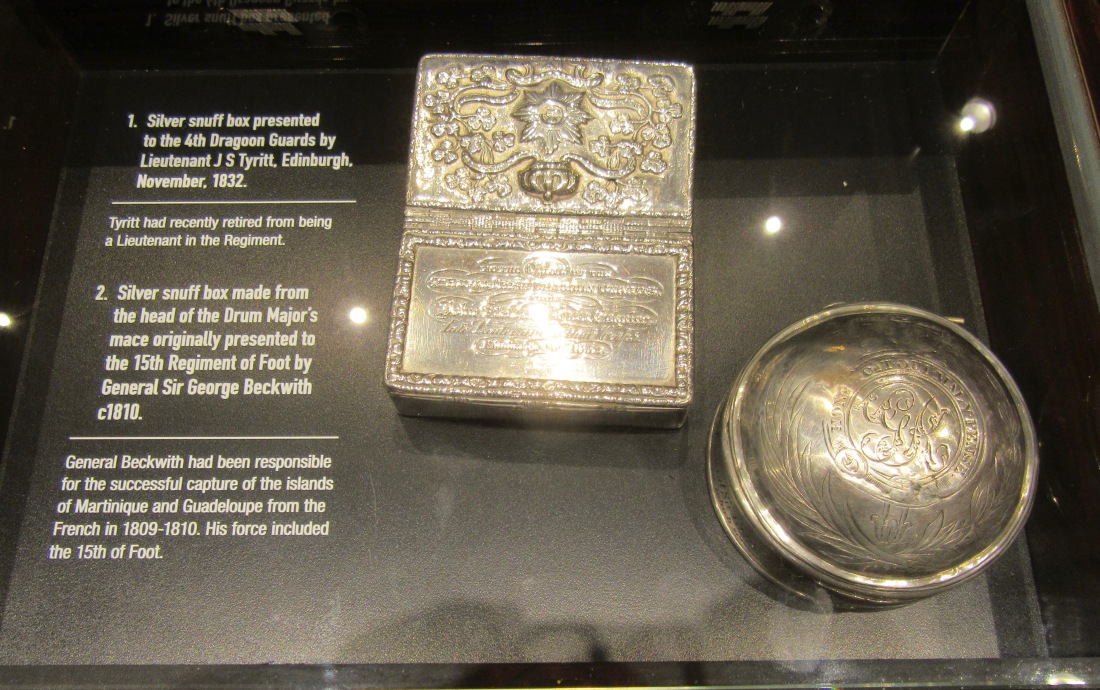This summer, I’m hoping to enhance this site both by adding some new articles and by posting in this blog section about various titbits of interesting information and anecdotes I have come across in my research. As a personal update, I have just finished an MPhil on duelling and courts-martial in the Napoleonic-era British army and will be starting a PhD this autumn on military music during the same period.
A couple months ago, I was in York for the ‘From Reason to Revolution‘ conference on eighteenth-century military history, held at the excellent and well-presented York Army Museum. While there, I noticed a rather intriguing artefact – a silver snuff box made from the head of the 15th Foot’s drum-major’s mace. It was presented to Lieutenant-General Sir George Beckwith as a mark of the corps’ esteem for his leadership during the capture of Martinique and Guadeloupe, important French Caribbean sugar islands, in 1809 and 1810 respectively.
The repurposing of the mace head for such a presentation piece underlines the fact that drum-major’s staffs were themselves often elaborate and finely-engraved trophies – prized (and costly) symbols of regimental prestige. But while some corps commissioned bespoke silver-tipped canes with royal and regimental insignia, units who managed to capture such maces from the French enjoyed both monetary savings and bragging rights. According to Sergeant Thomas Lawrence, the 40th Foot seized a ‘splendid drum-major’s staff from the enemy’ at the 1812 Battle of Salamanca, ‘which was stated to be worth at least £50, and it must have come in very useful, for ours was terribly worn and knocked about, being very old, having been itself taken from the French in Holland, during the commandership of the Duke of York [ie. either in 1794-5 or 1799].’ (Autobiography of Sergeant William Lawrence, 1886, p. 124-5)

But to return to the 15th Foot, while the 1st Battalion was sweltering in the disease-ridden West Indies, the 2nd Battalion, commanded by Lieutenant-Colonel William Sibbald, was stationed at Malton in Yorkshire in 1808. His wife Susan fondly recalled the 2/15th’s Drum-Major Alexander Cook in a passage from her memoirs, which also alludes to the drum-major’s role in retrieving and returning the regimental colours for parade.
“The Drum Major was a great character in his yellow coat trimmed with silver lace, cocked hat and a cane almost as tall as himself, and which he contrived to flourish in a peculiar manner at the time of the troup [sic – troop], which was a slow sort of figure march – I cannot call it a dance – that was performed by the band whilst the Commanding Officer on foot was inspecting the different companies of the Regiment. I had charge of the Regimental colours, which if they got wet on a field day Major Cook, as he was always called, would bring in and spread on the sides of my sitting room, and come again to furl when he thought them dry enough.” (Memoirs of Susan Sibbald, 1926, p. 255-6)
However flattering as this pen-portrait seems, Drum-Major Cook’s career was not entirely free from misadventure. In 1817, he was convicted of ‘Repeated unsoldierlike conduct and [being] drunk at Morning Parade’ and reduced to the rank of drummer. (UK National Archives, WO 27/142)

